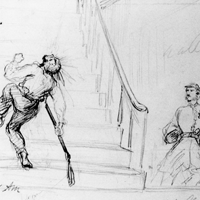Arthur Lumley (1837-1912)

Lumley was born in Dublin, Ireland and came to the United States around 1840 where he lived in Brooklyn. In the 1850s, he studied art at the National Academy of Design and supported himself by doing illustrations for books including The Life and Adventures of Kit Carson, the Nestor of the Rocky Mountains by DeWitt Peters (New York, 1858), Wild Life; or Adventures on the Frontier. A Tale of the Early Days of the Texan Republic by Captain Mayne Reid (New York, 1859), Kit Kelvin’s Kernels (New York, 1860), and Sacred Poems by N. Parker Willis (New York, 1860) as well as for the newly founded illustrated newspapers New York Illustrated, Harper’s Weekly, and Frank Leslie’s Illustrated Newspaper. In April 1861, Frank Leslie sent Lumley to Washington D.C. as a “special artist” to accompany General Irwin McDowell’s army as it traveled south into Virginia where it engaged the Confederate forces at Bull Run Creek. Lumley sketched large panoramic drawings of the Federal Army in its initially successful attack and did close-up studies of the bayonet charge of the New York City Fire Zoaves. When Confederate reinforcements counterattacked and broke the Federal assault, Lumley vividly captured the resulting panic as the Union Army retreated to Washington. In 1862, he went to work for New York Illustrated. In all, Leslie’s and New York Illustrated published 298 of Lumley’s wartime drawings. After the war, he did illustrations for Kilpatrick and Our Cavalry by James Moore (New York, 1865), The Culprit Fay, A Poem by Joseph Rodman Drake (New York, 1867), Harper’s Bazaar (New York, 1867-1870), Our New West, Records of Travel Between the Mississippi River and the Pacific Ocean by Samuel Bowles (Hartford, 1869), Ten Years in Wall Street by William Worthington Fowler (Hartford, 1870), Fanny Fern, A Memorial Volume by James Parton (New York, 1873), and The Hand-Book of Wyoming and Guide to the Black Hills and Big Horn Regions for Citizen, Emigrant, and Tourist by Robert Strahorn (Cheyenne, 1877). He also contributed drawings of social satire to The Daily Graphic, which was established in the early 1870s as the first illustrated daily newspaper in the United States. His drawing of “The Intelligent Juror”, for example, combines humor with an indictment of jurors for ignorance, prejudice, stupidity, indifference, slothfulness, and corruption. The Becker Collection contains drawings done by Lumley in Virginia between 1861 and 1862. See works by this artist.